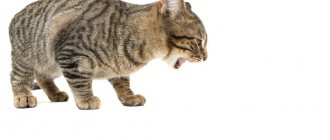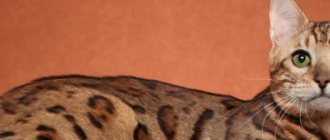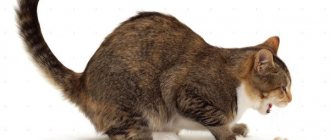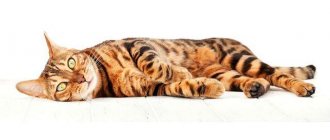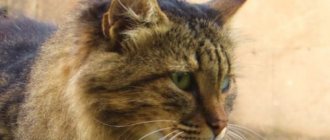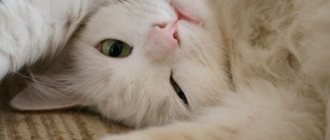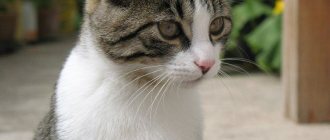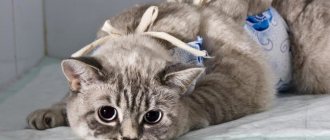Vomiting bile in a cat can be caused by problems related to the functioning of the animal’s digestive organs, or it can be a symptom of a dangerous disease. The owner's task is to watch the pet. If the vomiting does not stop or new alarming symptoms appear, the cat should be taken to a veterinarian as soon as possible.
Cat's vomit is yellow
Almost all owners panic when their cats vomit yellow liquid. But you need to pull yourself together and observe how often this happens.
If yellow vomit occurs once and there are no other symptoms, a visit to the veterinarian is not required. However, if a cat vomits yellow liquid for several hours or days, he needs to be seen by a specialist immediately - this indicates the accumulation of too much bile in the stomach.
In a kitten, vomiting yellow liquid usually occurs in the presence of congenital pathologies of the digestive organs. This condition requires immediate medical attention. After all, the smaller the kitten, the higher the likelihood of its death due to dehydration. Babies older than 3 months have a higher survival rate in this situation.
Important! Bile can eat away at the stomach lining. Its prolonged accumulation in the stomach leads to the development of inflammation of the digestive organs and even the appearance of ulcers.
The cat vomited bile: causes of vomiting, first aid methods, preventive measures
Unexpected changes in a pet's health are alarming to all owners. In a situation where a cat is vomiting bile, it can be difficult for the owner to determine the cause of the problem. The first thing that comes to mind is digestive problems. However, there are quite a few factors that cause bilious vomiting in cats. What can cause vomiting, how dangerous is the situation and what to do?
The main causes of bile vomiting in cats
There are many reasons why a cat vomits yellow liquid. Some of them are really related to digestion, but there are also those that are provoked by serious diseases.
Why did the cat vomit? Here are the main reasons:
- Abrupt introduction of high-calorie food into the diet. The cat's liver cannot withstand such a load, and food is poorly digested. The animal vomits yellow foamy liquid and burps frequently.
- Foreign body in the stomach. While walking around the house or street, a pet can “drag” some foreign object into its mouth. If it is small in size, it will leave the body with feces. When a foreign body is retained in the stomach, the cat’s digestive system begins to work at an accelerated pace, trying to digest the “stranger.” Anything that is not digested comes out in vomit.
- Fatty and stale food, animals swallowing large pieces of food, and frequent consumption of eggs provoke digestive problems. The pet vomits white foam when it is hungry.
- Hepatitis. A sick pet refuses to eat, the mucous membranes of its eyes turn yellow, diarrhea and vomiting appear, and an increase in temperature is observed.
- Plague. A dangerous disease that leads to complete disruption of the functions of various organs of the animal. One of the signs of the disease is nausea and the release of vomit consisting of bile.
- Liver failure. Easily identified by the unpleasant odor from the mouth, yellowing of the eye sclera and the apathetic state of the cat.
- Severe damage to the body by worms. In attempts to get rid of parasites, the body reacts in the form of vomiting with the release of bile.
- Lipidosis, or fatty liver. A sick animal quickly loses weight, stops eating, and often vomits bile.
- Gallbladder problems. This is a rare occurrence for cats, but a characteristic sign is the appearance of yellow foamy liquid when vomiting.
Bile reflux into the stomach can occur after taking antibiotics. Stomach bleeding is often caused by a tumor or stomach ulcer. In such cases, blood is observed in the vomit.
The presence of worms is manifested by the appearance of mucus in the vomit. Discharge in the form of white foam is a sign of hunger. When there is excessive flow of bile into the stomach, the vomit takes on a green tint.
Black vomit indicates peritonitis or intestinal obstruction.
Is yellow vomit dangerous?
Bile is an aggressive chemical compound that can cause serious harm to a cat's body. Once in an empty stomach, it corrodes the walls of the organ, provoking the formation of gastritis.
With a constant process, peptic ulcer develops. Prolonged vomiting leads to dehydration.
The process is especially dangerous for kittens: the baby’s body cannot cope with the rapid loss of fluid, and the animal dies.
Serious signals are an increase in temperature against the background of vomiting and the fact that the pet is not eating anything. Such symptoms may indicate the presence of a serious illness or severe infection. The appearance of mucus, blood, and a foul odor in the vomit should alarm the owner. With such symptoms, the likelihood of damage to the pet’s internal organs increases.
The admixture of bile in the vomit is easy to notice; it is colored in a brighter shade of yellow. This may mean that the animal has problems with the liver and bile ducts. Foam and pink vomit indicate internal bleeding in the animal's gastrointestinal tract. This is another alarm signal warning of the danger of the situation.
What should the owner do?
The measures that the owner should take depend on the nature of the vomiting and the frequency of its occurrence. A one-time vomiting in a cat is not a cause for concern and does not require any urgent treatment measures. If the animal vomits several times a day, you need to do the following:
- Stop giving your pet new food and do not feed until everything he has eaten is eliminated from the body. For subsequent meals, return to the previous type of food. The maximum time for which a cat should be weaned from food is 12 hours.
- Give your cat plenty to drink. The entry of fluid into the body will prevent dehydration, help remove toxins faster and stop irritation of the gastric mucosa.
- The consequences of improper feeding can be removed by taking activated carbon or Smecta. A strong mint decoction (10-15 ml) will also help. You'll have to force it into the animal.
- If drinking too much makes your cat burp, you need to give water in small portions every half hour. With this regimen, the urge to gag will decrease. Instead of water, you can prepare a chamomile decoction and give it to your pet.
When trying to help your pet at home, you should not resort to medications intended for the treatment of digestive disorders in humans. The specific composition of complex drugs can negatively affect the cat’s digestive system. If vomiting continues, the animal should be urgently taken to a veterinary clinic and undergo a full examination.
If a decision is made to visit a doctor, the owner must draw up an accurate verbal picture of the problem. At the appointment, you need to talk about when the vomiting started, at what intervals it occurs, what impurities are noticed in the vomiting fluid, and what it looks like. It is imperative to indicate what diseases the animal has, what food it eats, and whether there was an attempt to change food.
Vomiting in a pregnant cat
Pregnancy has a special effect on a cat's body. Sometimes excessive intoxication provokes vomiting, especially in the morning.
If the composition of the vomiting substance is homogeneous, white, does not have a fetid odor or dubious inclusions, there is no need to worry. Doctors attribute this process to common toxicosis of pregnant women.
It is enough to change the animal’s diet, introduce dietary types of food into it and provide plenty of fluids.
If a cat vomits late in pregnancy, the reason lies in the pressure of the fetus on the mother’s stomach. When the organ is filled with food, it is rejected; the excess, squeezed out by the kittens, comes out through the mouth, sometimes along with bile. There is no reason to worry, just reduce the portion a little so that the food is easily digested. Vomiting in a cat before giving birth is also a normal process.
Yellow vomit in a pregnant cat may indicate significant problems in the body. If the process is aggravated by diarrhea and repeats throughout the day, the cat should be shown to a doctor.
Before visiting the veterinarian, you should give your pet small doses of water or chamomile infusion, forcefully injecting them every 30 minutes.
It is prohibited to use any medications that can harm not only the cat, but also future kittens.
When do you need immediate veterinary help?
We examined the causes of yellow vomit, identified the culprits, and identified dangerous factors. However, concern for the pet can lead the owner to rash actions. Self-medication is not the best way to help your pet. Remember what symptoms indicate that the animal should be urgently shown to a specialist:
- frequent and profuse vomiting, which does not stop even when the animal’s stomach is already empty;
- the presence in the vomit of dangerous impurities in the form of blood, mucus, foam and particles of unknown origin;
- the release of foamy liquid does not stop for 3-4 hours;
- gradual change in the color and smell of vomit;
- rapid deterioration in the pet’s general condition;
- dry and hot nose (it is recommended to measure the temperature);
- the cat has seizures;
- lethargic cat behavior, loss of appetite, drowsiness.
The presence of additional symptoms indicating the seriousness of the situation also becomes a reason to visit a doctor. These include:
- breathing problems (fast or slow);
- profuse diarrhea (frequent bowel movements and watery stools);
- feverish state (at high temperature);
- visible bloating;
- the animal does not go to the toilet, which may be a symptom of volvulus (coprostasis).
A visit to the doctor is also required if vomiting occurs after injury to the animal. For example, if a cat falls from a height, the gallbladder may rupture, which will lead to vomiting of bile. Similar symptoms are caused by cholecystitis, which at first occurs in a latent form. If you suspect a certain disease, contact your veterinarian immediately.
When going to the clinic, do not forget to take documents for your pet. Make a preliminary call to the doctor, explain the situation so that the specialist has time to prepare to take urgent measures. Sometimes minutes count, so try to quickly get your pet to the hospital. Give him water during the trip to prevent fluid loss and relieve the condition.
Prevention measures
To prevent illness and protect your four-legged pet from health problems, preventive measures are called for, which are easy to follow if you are attentive to your furry friend. What to do:
- Create a balanced diet. Feed your cat high-quality brands of food, do not give fatty foods, and ensure that the animal’s body receives all the necessary vitamins and minerals.
- Give your pet an anthelmintic drug once a quarter. It is especially important to deworm cats and kittens that roam freely on the street or eat raw meat.
- Brush your pet periodically to prevent large amounts of hair from getting into its body. Cats are very clean and love to lick their fur, putting it in order. The villi enter the intestines and gather into a “sausage” that can get stuck there.
- Keep your pet's sleeping area clean, wash the dishes from which he eats, and disinfect bedding and toys.
- Bring your pet to the veterinarian regularly for examinations and vaccinations.
- Make sure that there are no small objects left on the floor that could attract the pet’s attention. Remember that a foreign body in the stomach is one of the causes of vomiting with bile.
- When switching to another type of food, consult your doctor.
- Remove poisonous plants from your home.
- Store cleaning and detergent products in a place that is well protected from your cat's prying eyes.
If your cat is vomiting, it is important to monitor its condition. Carefully study the nature of the vomit, make sure it is safe, or, if its appearance is alarming, show your pet to a doctor.
Special precautions must be taken for kittens. Kids are curious and careless.
Vacuum the house more often, do not leave food in a bowl so that it does not get airy, give special food for young animals.
The health of the pet is the main concern of the owner. In addition to regular visits to the doctor, follow preventive measures. Select food according to the age and breed of the animal. Learn to recognize the danger of vomiting by primary signs, watch your diet. Remember that the life of your beloved cat depends on your correct attitude to seemingly trifles.
Source: https://MurKoshka.ru/zdorovye/bolezni/kota-vyrvalo-zhelchyu.html
The mechanism of the gag reflex
Usually, owners believe that the cat vomited due to coughing. In fact, it is a symptom of vomiting, not a cause. The attack usually proceeds as follows:
- The cat appears to have increased salivation. She worries, constantly licks herself and swallows the saliva that forms.
- Then a cough begins, the animal breathes frequently and deeply, and stretches its head forward.
- The area of the pharynx and abdomen contracts, first fruitless vomiting appears, and then with the contents.
Important! For cats, vomiting every 3-4 days is normal.
Most often, cats vomit when they eat too quickly or eat too much. This often happens when feeding with low-quality industrial feed or with a mixed diet. Vomiting may also appear in the morning if the cat fell asleep hungry the day before.
If vomiting occurs from overeating, you just need to not let your pet eat or drink for 8 hours, and instead of water, offer to lick an ice cube. If a cat systematically vomits due to an incorrectly formulated diet, it needs to be reconsidered.
All long-haired cats also suffer from nausea and vomiting. When licked, the fur enters the stomach, where it gradually rolls into lumps, which cause irritation of the gastrointestinal tract. This is why burping fur should not be a concern. If there is blood, foam or mucus in the vomit, you should immediately contact the clinic.
Other predisposing factors
What are the reasons for this? There can be many of them. Firstly, it all depends on the animal. If your cat has a habit of greedily pouncing on food, gobbling up an entire bowl in a couple of seconds, then he can’t help but vomit. This often happens when a long-haired cat has a lot of hair accumulated in its stomach. It is possible that the pet simply ate something that smelled tempting but was inedible (the already mentioned sausage skins). Very often, a cat vomits bile with foam when he has some kind of liver or thyroid disease. Sometimes this is an indirect sign of the presence of heartworm.
Regurgitation may occur during the recovery period from surgery. In particular, after sterilization.
By the way, what is the danger of this pathology? The fact is that in most cases, bile enters an empty stomach. And this substance is a powerful chemical reagent, very aggressive towards unprotected tissues. Simply put, over time, bile literally eats away the gastric mucosa, which at best leads to gastritis, but much more often it ends in ulcerative lesions. This is very common in cats whose owners feed them once a day, but in large quantities. And dry food.
Causes of yellow vomit in cats
The correct diagnosis largely depends on the reasons why the cat is vomiting yellow liquid. If the owner remembers when the cat vomited for the first time, and how often it happened in the future, this will help in diagnosis.
Reasons why a cat vomits bile:
- Foreign body in the stomach. Often, while playing, kittens accidentally swallow small objects. If the item eaten is very small, it will pass out with the feces without any problems. If it is quite large in size, the cat’s body will begin to actively produce bile to speed up the digestive process. As a result, the cat will begin to feel nauseated, and along with the vomit, it will regurgitate excess bile.
- A sudden change in diet. Sometimes owners decide to switch their cat to a more nutritious and high-calorie food. If there is a sudden transition, he will vomit yellow liquid with the presence of remnants of undigested food. This is due to the fact that the liver's work slows down in such a situation, as it is not able to digest too much fatty food.
- Worm infestation. Helminthiasis is one of the most common causes of yellow liquid vomiting in cats. The body tries to rid itself of parasites, as in the case of a foreign body. Worms cause serious disturbances in the functioning of the digestive system. As a result, the cat vomits bile and does not eat anything.
- Gallbladder diseases. With any abnormalities and pathologies in the functioning of the gallbladder, cats usually vomit yellow liquid with foam and a distinct odor of bile. Sometimes diarrhea mixed with bile and blood appears. In such a situation, you should immediately go to the veterinarian.
- Pregnancy. During pregnancy, all existing diseases in the cat will worsen. Some pregnant cats vomit yellow liquid. This indicates that they have problems with the gallbladder and its ducts.
- Infectious diseases. Vomiting of yellow liquid can be observed in cats with hepatitis, herpes, rhinotracheitis, panleukopenia (feline distemper). In addition to this symptom, weakness, watery diarrhea, and bad breath are observed. A pet can vomit not only after eating, but also on an empty stomach.
- Postoperative period. Sometimes cats may experience complications after various operations. Vomiting of yellow liquid mixed with blood, foam, brown or green mucus appears. The cat becomes inactive, and his health rapidly deteriorates. The animal's nose remains dry and warm, the fur loses its shine and begins to roll into lumps. In case of any postoperative complications, you must show your pet to a doctor who will select the necessary treatment for him.
Important! Large objects eaten by a cat cannot be removed by its intestines, so the pet may well experience a blockage in the stomach or esophagus. If you accidentally swallow various objects, it is better to play it safe and take your cat to see a veterinarian.
Important! Heartworm infection can also be a reason why your cat is vomiting bile.
The main causes of vomiting bile
Cleansing the stomach of undigested or excess food and non-food irritants is a physiological process associated with the digestive characteristics of predatory animals.
Vomiting is a protective mechanism for the cat's digestive system, which works as follows: intra-abdominal pressure increases sharply, and the contents of the stomach are pushed out through the mouth. The color, smell, and texture of vomit may look different depending on what triggered the reflex.
Foamy white discharge indicates that the pet is hungry, with an admixture of mucus - about helminthic infestations, pink or reddish - about the presence of blood in the stomach, which is possible with a tumor or peptic ulcer, too dark - about intestinal obstruction or peritonitis.
The yellow (green if excessive amount) tint is given to the vomit by bile, a liquid with a specific odor that enters the duodenum through the bile ducts and is involved in the digestive processes.
What explains the presence of yellow color
In a cat's normal condition, bile masses should not enter its stomach. The chemically active liquid corrodes its walls, which leads to inflammation and ulceration of this organ.
Vomiting acquires a yellow tint when the process is repeated many times and the animal’s stomach becomes empty, but even a one-time regurgitation should alert the pet owner - it can be caused not only by physiological factors associated with digestion, but also by dangerous diseases.
The main causes of vomiting bile:
- Abundant food - the digestive system cannot cope with large volumes of food and spontaneously throws out excess food through the animal’s mouth. Such discharge contains saliva, pieces of food, and is accompanied by white or yellow foam.
- Wrong diet - fatty foods and dry food are difficult to digest and can cause nausea and vomiting. The consequences are eliminated by a special diet, alternating food and natural products, and ensuring sufficient drinking.
- Ingestion of fur and foreign objects - during the licking process, fur constantly enters the cat’s stomach, clumps into clumps and causes a gag reflex. Small foreign bodies are passed out with feces; the digestive system cannot cope with larger ones and gets rid of them through the mouth.
- Panleukopenia (distemper). Vomit in this dangerous disease consists of a yellow or white foaming liquid without any impurities (food particles or hair).
- Infectious diseases. Symptoms of rhinotracheitis, herpes, calicivirus and other feline infections include yellow vomit and watery diarrhea.
- Injuries - lesions of the lungs and bronchi are accompanied by the release of vomit with white foam, the liver and gall bladder - yellow, and inclusions of blood may be observed. There are no other symptoms associated with the functioning of the gastrointestinal tract.
- Infection with helminths. With severe infestation, rapid intoxication of the animal’s body with waste products of worms occurs, causing vomiting.
- Liver pathologies - hepatitis, obesity (lipidosis), liver failure, etc., less often - gallbladder (cholecystitis). In addition to regurgitation of bile, they are often accompanied by yellowing of the eye sclera, loss of appetite and general lethargy of the animal.
- Surgical intervention. Vomiting after surgery indicates complications or may occur after the use of anesthesia.
In some cases, the gag reflex in cats occurs when taking antibiotics or overdosing with other drugs as a reaction to suppressed liver function.
Associated symptoms
Yellow vomiting in a cat may be accompanied by additional symptoms depending on the cause that led to its appearance:
- the presence of hairballs, food particles, foam in the vomit;
- refusal to eat;
- deterioration in wool quality;
- constipation.
If you are repeatedly vomiting yellow liquid, you should give your cat something to drink as often as possible. If he does not drink on his own, it is recommended to pour liquid into his mouth every half hour to prevent dehydration. There is no need to feed the cat during this period.
Important! It is strictly forbidden to give your cat antiemetic drugs without a doctor's prescription.
If your pet's condition does not improve within a day, you should take him to the veterinarian.
When do you need immediate veterinary help?
We examined the causes of yellow vomit, identified the culprits, and identified dangerous factors. However, concern for the pet can lead the owner to rash actions. Self-medication is not the best way to help your pet. Remember what symptoms indicate that the animal should be urgently shown to a specialist:
- frequent and profuse vomiting, which does not stop even when the animal’s stomach is already empty;
- the presence in the vomit of dangerous impurities in the form of blood, mucus, foam and particles of unknown origin;
- the release of foamy liquid does not stop for 3-4 hours;
- gradual change in the color and smell of vomit;
- rapid deterioration in the pet’s general condition;
- dry and hot nose (it is recommended to measure the temperature);
- the cat has seizures;
- lethargic cat behavior, loss of appetite, drowsiness.
The presence of additional symptoms indicating the seriousness of the situation also becomes a reason to visit a doctor. These include:
- breathing problems (fast or slow);
- profuse diarrhea (frequent bowel movements and watery stools);
- feverish state (at high temperature);
- visible bloating;
- the animal does not go to the toilet, which may be a symptom of volvulus (coprostasis).
A visit to the doctor is also required if vomiting occurs after injury to the animal. For example, if a cat falls from a height, the gallbladder may rupture, which will lead to vomiting of bile. Similar symptoms are caused by cholecystitis, which at first occurs in a latent form. If you suspect a certain disease, contact your veterinarian immediately.
When going to the clinic, do not forget to take documents for your pet. Make a preliminary call to the doctor, explain the situation so that the specialist has time to prepare to take urgent measures. Sometimes minutes count, so try to quickly get your pet to the hospital. Give him water during the trip to prevent fluid loss and relieve the condition.
When you need to see a doctor urgently
Sometimes a cat develops symptoms that signal that the animal requires immediate professional help:
- Frequent vomiting that lasts more than 5–10 hours. If your cat has vomited more than once and is constantly thirsty, she most likely has kidney problems.
- Temperature increase.
- Weakness and apathy.
- Very unpleasant smell of vomit and the same smell from the mouth.
- Diarrhea.
- Convulsions or fainting.
- Presence of blood or mucus in the vomit.
- Refusal of water and food. If your cat is vomiting but refuses to eat and loses weight, you may have lipidosis. With this pathology, too much fat accumulates in the liver area. As a result, the functioning of most organs is disrupted, and toxins accumulate in the body itself. A cat showing signs of lipidosis must be hospitalized as soon as possible, otherwise it will die.
- Fountain vomiting.
- Darkening of urine.
- Yellowness of the mucous membranes.
- Problems with passing urine. Sometimes, when vomiting and increased thirst, cats practically do not go to the toilet. This most often occurs when the animal's urinary tract is blocked by stones or worms. In such a situation, urgent surgical intervention will save the cat from death.
General information
To begin with, we will describe the common reasons that can lead to yellowing of vomit. These include:
- Cat eating “non-food” objects. It occurs when a pet eats to its heart's content artificial casings from sausages or sausages. A similar phenomenon is observed in cases of eating chicken or fish bones, fragments of which remain in the stomach for a long time and irritate its mucous membrane, promoting the release of bile.
- This happens when a pet does not eat anything for a long time (illness, apathy), and then quickly makes up for lost time, gorging itself on a full bowl. There is a powerful release of bile, which irritates the gastric mucosa and causes profuse vomiting.
- When eating something poisonous, poisoning, infectious diseases, severe helminthic infestations. Worms not only release large amounts of toxins into the blood, but are also a strong irritant.
- Cancer should not be discounted . In particular, when a cat vomits bile and blood, this may well indicate the presence of a tumor in its digestive tract.
By the way, in cats, unlike dogs, slightly yellowed vomit is not a cause for serious concern . When these animals vomit, some amount of bile almost always gets into the contents of the stomach, and there is nothing wrong with that. Surely every experienced cat lover can confirm this. The yellowness is especially noticeable when the cat has eaten grass for “self-cleaning” and then vomited.
Cause for alarm appears when cats vomit bile, even if the pet has not eaten or drunk anything. If your cat vomits from time to time, but this happens after consuming a small amount of liquid or food, but you know for sure that he could not eat anything poisonous, just watch the animal for one day. This recommendation is related to the physiological characteristics of digestion in these animals.
Typically, a cat digests food within eight hours. If vomiting occurs before this period, you will see lumps of undigested food mixed with a small amount of yellowish mucus. Accordingly, when vomiting occurs when the stomach is already empty, the owner will see only thick mucus with numerous streaks of bile. In the second case, the pathology is clearly more serious.
Diagnostic measures
In a veterinary clinic, if a yellow liquid is vomiting, the doctor will carefully examine the cat, palpate its stomach, check its mucous membranes and measure its body temperature. Next, he will need detailed information about the cat’s condition, as well as documents with notes on vaccination, deworming and previous diseases.
To make a correct diagnosis, the following manipulations are usually performed:
- X-ray of the intestines, liver, bladder;
- CT scan;
- Ultrasound of internal organs;
- endoscopy;
- biochemical and general blood test;
- analysis of stool, vomit and urine.
Owners should not refuse diagnostic measures, because they are all aimed at saving the cat’s life. Unfortunately, even modern diagnostic methods do not always make it possible to find out the causes of vomiting yellow liquid, so they often complement each other. For example, ultrasound and x-rays will not help determine poisoning, and also do not always show acute inflammatory processes in the gallbladder and liver. This is why doctors prescribe additional tests.
What should the owner do?
The measures that the owner should take depend on the nature of the vomiting and the frequency of its occurrence. A one-time vomiting in a cat is not a cause for concern and does not require any urgent treatment measures. If the animal vomits several times a day, you need to do the following:
- Stop giving your pet new food and do not feed until everything he has eaten is eliminated from the body. For subsequent meals, return to the previous type of food. The maximum time for which a cat should be weaned from food is 12 hours.
- Give your cat plenty to drink. The entry of fluid into the body will prevent dehydration, help remove toxins faster and stop irritation of the gastric mucosa.
- The consequences of improper feeding can be removed by taking activated carbon or Smecta. A strong mint decoction (10-15 ml) will also help. You'll have to force it into the animal.
- If drinking too much makes your cat burp, you need to give water in small portions every half hour. With this regimen, the urge to gag will decrease. Instead of water, you can prepare a chamomile decoction and give it to your pet.
When trying to help your pet at home, you should not resort to medications intended for the treatment of digestive disorders in humans. The specific composition of complex drugs can negatively affect the cat’s digestive system. If vomiting continues, the animal should be urgently taken to a veterinary clinic and undergo a full examination.
If a decision is made to visit a doctor, the owner must draw up an accurate verbal picture of the problem. At the appointment, you need to talk about when the vomiting started, at what intervals it occurs, what impurities are noticed in the vomiting fluid, and what it looks like. It is imperative to indicate what diseases the animal has, what food it eats, and whether there was an attempt to change food.
Treatment methods
After receiving the results of all tests, the veterinarian will individually select a treatment method.
First of all, you will need to restore the water-salt reserves in the cat’s body. For this purpose, droppers with Ringer-Locke solution are used. In addition, the pet will have to be put on a diet: include nutritious but light food in its diet.
Typically cats are treated with the following medications:
- Sorbents and antitoxins. They are prescribed if a cat has been poisoned by some toxic substances.
- Antispasmodics and antiemetics.
- Medicines to protect the stomach and maintain liver function.
- Vitamins and immunomodulators.
- Antibiotics. Prescribed if the cause of vomiting yellow liquid is any infectious disease
- Antihelminthic drugs.
If vomiting yellow liquid, which was caused by improper feeding, the pet can be treated at home with Smecta or activated carbon. Dosage: 1 tablet or 1 ml per 1 kg of weight. You can also give your cat a strong mint decoction to drink.
If you vomit yellow liquid once, it is recommended to postpone feeding for 8 hours. Instead of water, it is better to let your cat lick an ice cube so as not to cause another attack of vomiting. At the end of the break, you need to give your pet something to drink and carefully monitor its reaction. If there is no nausea, you can feed the cat thin porridge, boiled lean fish or meat. From the next day, stick to your normal diet.
If a cat vomits bile, the owner must carefully monitor the condition of his pet in order to protect him from unpleasant health consequences and death. The best way to combat vomiting is to prevent its occurrence. The cat needs to be provided with competent care: selection of diet, vaccination, deworming, combing and other mandatory manipulations.
Substitute Products
You can treat your pet to boiled fish, but not often.
Veterinarians say that it is better for the cat to eat other foods that contain no less useful components instead of a chicken bone. You can replace bone mince with the following dishes:
- Fish. When a cat eats such a product, you should also carefully monitor it so that it does not choke on the bone. It is strictly forbidden to replace the main food with it; fish should only serve as an additive. It is allowed to feed your pet this dish 1-2 times a week, but it is allowed only in boiled form.
- Special bones. They consist of tendons and movable joints in crushed form, as well as beef stomachs.
It is best to give preference to specialized dry food for cats, which must be given to the animal in a certain dosage. This food is as balanced as possible, since it contains all the beneficial microelements in the quantities necessary for the cat’s body. When purchasing a product, the age and health of the pet are taken into account. It is equally important to read the composition of the product, because if it contains flavorings, preservatives and salt, then you should not choose such dry food. It is important for the owner to understand that only premium and super-premium products will be useful. If your cat still wants to eat chicken bones, then you should give them with leftover meat and cartilage. In this case, the pet will satisfy its hunting urges and will not cause harm to the body.
How to make things easier for the veterinarian
After providing first aid, do not hesitate to go to the nearest veterinary clinic. Try to take with you a sample of the substance that poisoned the cat (of course, if this can be done without endangering your health and the health of others). If you do not know what caused the painful condition, then it would be useful to take a small sample of vomit with you, describe to the doctor all the symptoms, how the animal’s condition worsened, and in what order the negative consequences appeared. It is advisable to tell the doctor what medications the cat is allergic to, whether the cat is currently sick, and whether there are any chronic diseases.

